Standard [CURRENT]
ASTM D 8237:2021
Standard Test Method for Determining Fatigue Failure of Asphalt-Aggregate Mixtures with the Four-Point Beam Fatigue Device
- Publication date
- 2021
- Original language
- English
- Pages
- 12
- Publication date
- 2021
- Original language
- English
- Pages
- 12
- DOI
- https://dx.doi.org/10.1520/D8237-21
Product information on this site:
Quick delivery via download or delivery service
Buy securely with a credit card or pay upon receipt of invoice
All transactions are encrypted
Short description
1.1 This test method provides a procedure for determining a fatigue curve that is developed using three or more strain levels. The resulting data can be used in the fatigue models for mechanistic-empirical pavement design (that is, Pavement ME). Failure points are determined for estimating the fatigue life of 380 mm long by 50 mm thick by 63 mm in breadth (width) asphalt mixture beam (rectangular prism) specimens sawed from laboratory or field-compacted asphalt mixture, which are subjected to repeated flexural bending. 1.2 The largest nominal maximum aggregate size (NMAS) recommended for beams 50 mm thick is 19 mm. Beams made with an NMAS greater than 19 mm might significantly interfere with the material response, thereby affecting the repeatability of the test. 1.3 The text of this standard references notes and footnotes which provide explanatory material. These notes and footnotes (excluding those in tables and figures) shall not be considered as requirements of the standard. 1.4 Units- The values stated in SI units are to be regarded as standard. No other units of measurement are included in this standard, with the exception of degrees (°) where angle is specified in accordance with IEEE/ASTM SI 10 . 1.5 This standard does not purport to address all of the safety concerns, if any, associated with its use. It is the responsibility of the user of this standard to establish appropriate safety, health, and environmental practices and determine the applicability of regulatory limitations prior to use. 1.6 This international standard was developed in accordance with internationally recognized principles on standardization established in the Decision on Principles for the Development of International Standards, Guides and Recommendations issued by the World Trade Organization Technical Barriers to Trade (TBT) Committee.
ICS
93.080.20
DOI
https://dx.doi.org/10.1520/D8237-21
Also available in
Loading recommended items...
Loading recommended items...
Loading recommended items...
Loading recommended items...

